|
|
| Zeile 39: |
Zeile 39: |
| Bild:Sarah12.jpg|'''Malerei'''. This window depicts Painting by showing a painter and his nude model. | | Bild:Sarah12.jpg|'''Malerei'''. This window depicts Painting by showing a painter and his nude model. |
| Bild:Sarah13.jpg|'''Musik.''' These windows depict Music (soothing the savage beast on the right), and if you look at the top of the window, you will see [[Mozart]] and Beethoven, | | Bild:Sarah13.jpg|'''Musik.''' These windows depict Music (soothing the savage beast on the right), and if you look at the top of the window, you will see [[Mozart]] and Beethoven, |
| Bild: | | Bild:Sarah14.jpg|'''Recht und Gesetz'''. These windows depict the Law, with the Wisdom of the Law on the left and the Power of the Law on the right |
| Bild: | | Bild:Sarah15.jpg|'''Medizin.''' These windows depict Medicine, both in practice and in research (with the skull on the right) |
| Bild: | | Bild: |
| </gallery> | | </gallery> |
Version vom 12. September 2010, 20:54 Uhr
Seite im Aufbau / site under construction /Bitte übersetzen !
Scottish Rite Cathedral
Die Scottish Rite Cathedral befindet sich an der 650 N. Meridian Street in der Innenstadt von Indianapolis. Die Kathedrale wurde in den Jahren 1927-1929 im neugotischen Stil erbaut.
The Scottish Rite Cathedral is located at 650 N. Meridian Street in downtown Indianapolis. It was built in 1927-1929 in the Neo-Gothic style. The Scottish Rite is a branch of Freemasonry.
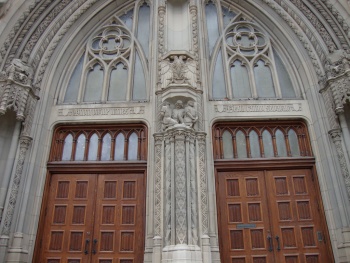
Foto mit freundlicher Erlaubnis von
Sarah: Eastern portal of the Scottish Rite. This is the eastern entrance of the Sottish Rite Cathedral (located on Meridian Street). The portal features the Masonic double-headed eagle of Lagash and sculptures of the first Grand Masters. The words above the doors read: "Whom virtue unites, death cannot separate".
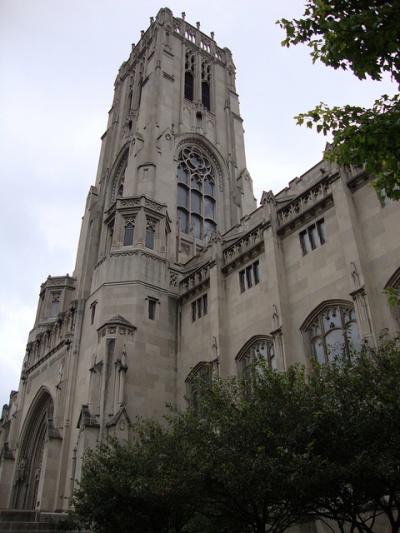
Foto mit freundlicher Erlaubnis von
Sarah: A view of the bell tower of the Scottish Rite Cathedral, showcasing the Neo-Gothic style of the bell tower and facade.

Foto mit freundlicher Erlaubnis von
Sarah: Eastern portal of the Scottish Rite. A view up the bell tower facade from street level. The bell tower rises 212 feet and contains a 54-bell carillon.
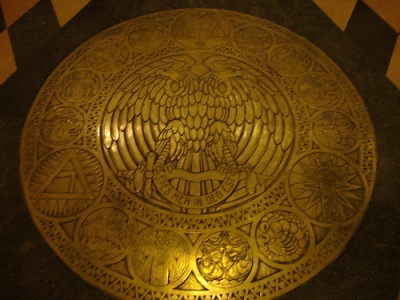
Foto mit freundlicher Erlaubnis von
Sarah: Tiler's Room floor medallion In the center of the floor of the Tiler's Room is this medallion. In the center is the Masonic Double-headed Eagle of Lagash with the slogan "Spes mea in deo est" (My hope is in God). The eagle is surrounded by the twelve signs of the zodiac and the three symbols of Scottish Rite Freemasonry (in the larger circles). The signs of zodiac were included in this design to remind Scottish Rite members to pursue enlightenment in all 12 months of the year.
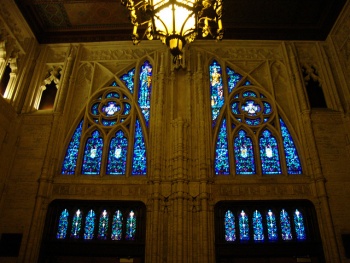
Foto mit freundlicher Erlaubnis von
Sarah: Above the eastern portal. The art glass windows above the eastern portal into the Scottish Rite. Most of the windows are art glass, not traditional stained glass. The figures and details are painted onto the glass, which is then fired to set the designs.
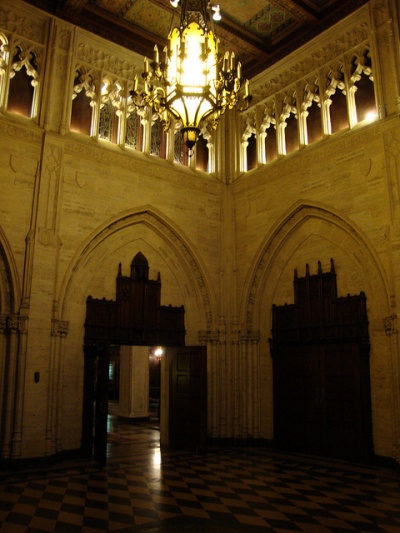
Foto mit freundlicher Erlaubnis von
Sarah: The Tiler's Room. The Tiler's Room is the main entrance to the Scottish Rite Cathedral (off of Meridian Street, within the eastern portal). This room is a perfect cube -- 33 feet wide, 33 feet long, 33 feet high. The entire Scottish Rite is based on units of 33 because Christ lived for 33 years and the highest possible degree in Scottish Rite Freemasonry is the 33rd degree.
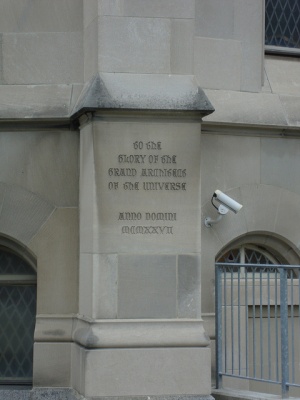
Scottish Rite Cathedral inscription "To the Glory of the Grand Architect of the Universe" -- I think that says it all. The Scottish Rite Masons are a non-denomination Masonic order who only require initiates to make an oath professing a belief in a higher power, and this slogan on the cornerstone underscores that universality. With kindly permission of
SarahBleiglasfenster / Stained glass windows
All pictures in this gallery with kindly permission of Sarah. Alle Fotos dieser Galerie mit freundlicher Erlaubnis von Sarah. On the other side of the south lounge at the Scottish Rite Cathedral, there are a series of art glass windows depicting the Arts and Sciences. These windows have a warmer light quality compared to the Masonic Degree windows because the artisans learned to incorporate precious metals (gold and silver) into the glass paints to preserve the true colors after firing.
Wissenschaften und Kunst. This window depicts Engineering, with nods to maritime, aeronautical, mechanical, and civil engineering.
Elektrizität. This window depicts Electricity. At the top, electricity is credited for "light, sound, and electric transportation", while the bottom panel describes electricity as "The caveman's terror, civilization's blessing".
Bildhauerei. This window depicts Sculpture, with tributes to Michelangelo, the Egyptians, and a classical sculptor.
Architektur. This window depicts Architecture, and the background details are amazing. The side borders describe various types of columns, the backgrounds behind the main figures show cathedrals, and the bottom panel shows a Mayan temple and the Leaning Tower of Pisa.
Malerei. This window depicts Painting by showing a painter and his nude model.
Musik. These windows depict Music (soothing the savage beast on the right), and if you look at the top of the window, you will see Mozart and Beethoven,
Recht und Gesetz. These windows depict the Law, with the Wisdom of the Law on the left and the Power of the Law on the right
Medizin. These windows depict Medicine, both in practice and in research (with the skull on the right)
Links















